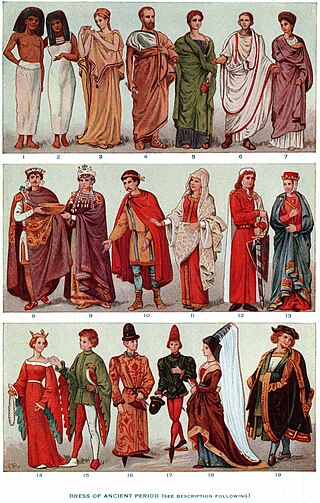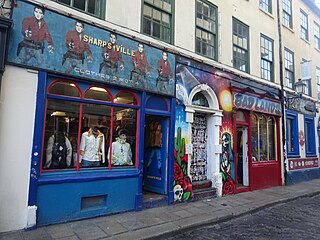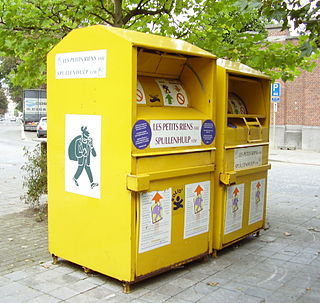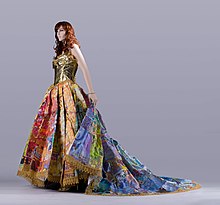
Clothing is any item worn on the body. Typically, clothing is made of fabrics or textiles, but over time it has included garments made from animal skin and other thin sheets of materials and natural products found in the environment, put together. The wearing of clothing is mostly restricted to human beings and is a feature of all human societies. The amount and type of clothing worn depends on gender, body type, social factors, and geographic considerations. Garments cover the body, footwear covers the feet, gloves cover the hands, while hats and headgear cover the head, and underwear covers the private parts.

Textile is an umbrella term that includes various fiber-based materials, including fibers, yarns, filaments, threads, different fabric types, etc. At first, the word "textiles" only referred to woven fabrics. However, weaving is not the only manufacturing method, and many other methods were later developed to form textile structures based on their intended use. Knitting and non-woven are other popular types of fabric manufacturing. In the contemporary world, textiles satisfy the material needs for versatile applications, from simple daily clothing to bulletproof jackets, spacesuits, and doctor's gowns.

Vintage clothing is a generic term for garments originating from a previous era, as recent as the 1990s. The term can also be applied in reference to second-hand retail outlets, e.g. in vintage clothing store. While the concept originated during World War I as a response to textile shortages, vintage dressing encompasses choosing accessories, mixing vintage garments with new, as well as creating an ensemble of various styles and periods. Vintage clothes typically sell at low prices for high-end name brands.

Textile design, also known as textile geometry, is the creative and technical process by which thread or yarn fibers are interlaced to form a piece of cloth or fabric, which is subsequently printed upon or otherwise adorned. Textile design is further broken down into three major disciplines: printed textile design, woven textile design, and mixed media textile design. Each uses different methods to produce a fabric for variable uses and markets. Textile design as an industry is involved in other disciplines such as fashion, interior design, and fine arts.

Fast fashion is the business model of replicating recent catwalk trends and high-fashion designs, mass-producing them at a low cost, and bringing them to retail quickly while demand is at its highest. The term fast fashion is also used generically to describe the products of this business model, particularly clothing and footwear. Retailers who employ the fast fashion strategy include Primark, H&M, Shein, and Zara, all of which have become large multinationals by driving high turnover of inexpensive seasonal and trendy clothing that appeals to fashion-conscious consumers.
The study of the history of clothing and textiles traces the development, use, and availability of clothing and textiles over human history. Clothing and textiles reflect the materials and technologies available in different civilizations at different times. The variety and distribution of clothing and textiles within a society reveal social customs and culture.

Textile recycling is the process of recovering fiber, yarn, or fabric and reprocessing the material into new, useful products. Textile waste is split into pre-consumer and post-consumer waste and is sorted into five different categories derived from a pyramid model. Textiles can be either reused or mechanically/chemically recycled.

Upcycling, also known as creative reuse, is the process of transforming by-products, waste materials, useless, or unwanted products into new materials or products perceived to be of greater quality, such as artistic value or environmental value.

Sustainable fashion is a term describing efforts within the fashion industry to reduce its environmental impacts, protect workers producing garments, and uphold animal welfare. Sustainability in fashion encompasses a wide range of factors, including cutting CO2 emissions, addressing overproduction, reducing pollution and waste, supporting biodiversity, and ensuring that garment workers are paid a fair wage and have safe working conditions.

Clothing technology describes advances in production methods, material developments, and the incorporation of smart technologies into textiles and clothes. The clothing industry has expanded throughout time, reflecting advances not just in apparel manufacturing and distribution, but also in textile functionality and environmental effect. The timeline of clothing and textiles technology includes major changes in the manufacture and distribution of clothing.

Micro-sustainability is the portion of sustainability centered around small scale environmental measures that ultimately affect the environment through a larger cumulative impact. Micro-sustainability centers on individual efforts, behavior modification, education and creating attitudinal changes, which result in an environmentally conscious individual. Micro-sustainability encourages sustainable changes through "change agents"—individuals who foster positive environmental action locally and inside their sphere of influence. Examples of micro-sustainability include recycling, power saving by turning off unused lights, programming thermostats for efficient use of energy, reducing water usage, changing commuting habits to use less fossil fuels or modifying buying habits to reduce consumption and waste. The emphasis of micro-sustainability is on an individual's actions, rather than organizational or institutional practices at the systemic level. These small local level actions have immediate community benefits if undertaken on a widespread scale and if imitated, they can have a cumulative broad impact.

Cotton recycling is the process of converting cotton fabric into fibers that can be reused into other textile products.

Clothing industry or garment industry summarizes the types of trade and industry along the production and value chain of clothing and garments, starting with the textile industry, embellishment using embroidery, via the fashion industry to apparel retailers up to trade with second-hand clothes and textile recycling. The producing sectors build upon a wealth of clothing technology some of which, like the loom, the cotton gin, and the sewing machine heralded industrialization not only of the previous textile manufacturing practices. Clothing industries are also known as allied industries, fashion industries, garment industries, or soft goods industries.
Natalie "Alabama" Chanin is an American fashion designer from Florence, Alabama. From 1976 until its closure in 2005, Tee-Jays Manufacturing was one of the largest employers in the Florence textile industry. Chanin's business now operates as a clothing manufacturer on the grounds of the former Tee-Jays company and is now a part of the zero-waste fashion movement. Her design company uses organic cotton fabric in their designs. Chanin's "open source" philosophy means that patterns and techniques for some of her garments are openly available through books and workshops.

Slow fashion is an aspect of sustainable fashion and a concept describing the opposite to fast fashion, part of the "slow movement" advocating for clothing and apparel manufacturing in respect to people, environment and animals. As such, contrary to the industrial practices of fast fashion conglomerates, slow fashion involves local artisans and the use of eco-friendly materials, with the goal of preserving crafts and the environment which, ultimately, provides value to all, slow fashion brands, consumers and retailers.

The Hong Kong Research Institute of Textiles and Apparel (HKRITA) is a public research institute in Hong Kong. It was established in April 2006 and hosted by The Hong Kong Polytechnic University (PolyU). With funding support from the Innovation and Technology Commission, HKSAR Government, it acts as a focal point to enhance technological innovation in textiles and apparel industry for the development of highly competitive industrial clusters in Hong Kong and the Greater Bay Area.

The fashion industry, particularly manufacture and use of apparel and footwear, is a significant driver of greenhouse gas emissions and plastic pollution. The rapid growth of fast fashion has led to around 80 billion items of clothing being consumed annually, with about 85% of clothes consumed in United States being sent to landfill.
Econyl regenerated nylon is a material introduced in 2011 by Aquafil. It is made entirely from waste otherwise polluting the Earth, such as industrial discards, fabric scraps from clothing manufacturing companies, old carpets and fishing nets. The material has been used by Stella McCartney, Kelly Slater's label Outerknown, Adidas and Speedo swimwear, Levi's, Breitling, and many other brands from the fashion and interior industries.
Recover Textile Systems, mainly known as Recover™, is a materials science company and producer of mechanically recycled cotton fiber and recycled cotton fiber blends, created in 2020 with its headquarters in Banyeres de Mariola, Spain.

Vintage clothing, or "Vintage", is a colloquialism commonly used to refer to all old styles of clothing. A widely accepted industry standard is that items made between 20 and 100 years ago can be considered "vintage" if they clearly reflect the styles and trends of the era they represent. In recent years, the popularity of vintage clothing has grown, as consumers seek unique and sustainable fashion options.

















